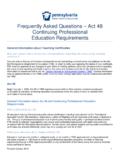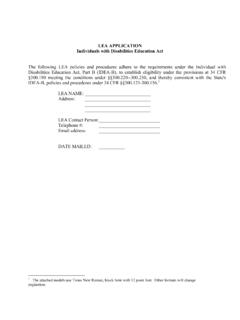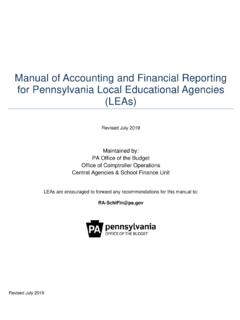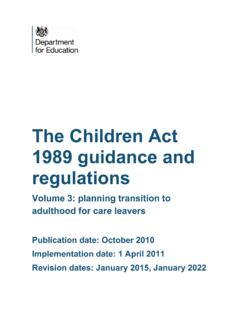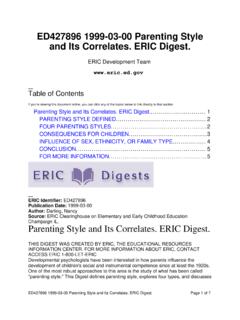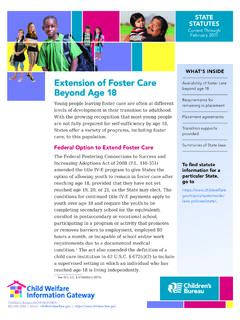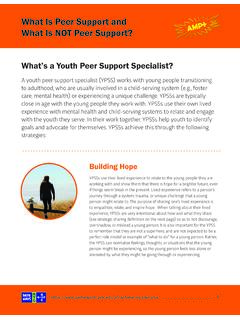Transcription of Overview of Career Development Theory
1 Overview of Career Development TheoryThe Career Development movement in the United States has paralleled other factors critical to the nation s growth. It is justwithin the past few years that the Career selection strategies selected by school counselors have been called into impact that Career Development has upon young persons is long-term and inestimable. For it is through the process ofcareer Development that an individual fashions a work identity (Tiedeman & O Hara, 1963).However, in today s world, fashioning a work identity may well be translated into fashioning an identity. In theAmerican culture, we are what we do.
2 More frequently we are asked What do you do? rather than Who are you? Forthe young, this decision is critical in determining the outcome of their below are some of the most frequently cited Career Development theories. Some of these theories have longtenure while others are newly evolving to address the emerging issues that gender, race and social class , Ginsburg, Axelrad and Herma Theory 1951 Recognizing that vocational choice is influenced by four facts: the reality factor, the influence of the educational process,the emotional factor and individual values this Theory proposes that it is a Development path that leads to Career in preteen and ending in young adulthood, individuals pass through three stages: fantasy, tentative and realistic.
3 Inthe fantasy stage, the child is free to pursue any occupational choice. Through this process the child s preferred activitiesare identified and related to future Career choices. Beginning in the preteen years and continuing through high school, theyoung person further defines their interests in, capacity for and values of an occupational choice. The cumulative effect ofthe process is the transition process in which the adolescent begins the Career choice process, recognizes the consequencesand responsibility of that realistic stage, spanning from mid-adolescence through young adulthood, has three sub-stages: exploration,crystallization and specification.
4 In the exploration stage the adolescent begins to restrict choice based on personallikes, skills and abilities. In the crystallization stage an occupational choice is made. Followed by the specificationstage where the individual pursues the educational experiences required achieving his Career this Theory fit with every adolescent s Career choice process? No. It has been recognized that issues of gender,race and social class come into play to open or close doors of occupational s Theory of Vocational Choice 1954 Donald Super has generated a life span vocational choice Theory that has six life and Career Development stages.
5 Thesesix stages are:1. The crystallization stage, ages 14-182. Specification stage, ages 18-213. Implementation stage, ages 21-244. The stabilization stage, ages 24-355. Consolidation, age 356. Readiness for retirement, age 55 One of Super s greatest contributions to Career Development has been his emphasis of the role self-conceptdevelopment plays. Super recognized that the self-concept changes and develops throughout people s lives as a resultof experience. People successively refine their self-concept(s) over time and application to the world of work createsadaptation in their Career the Career Development Theory provides a foundation for the professional work force it s research hasomitted women, people of color and the poor.
6 With the changing work force and nature of work the Theory has beencalled into s Career Typology 1959 John Holland s Theory is grounded in what he calls modal personal orientation or a developmental process establishedthrough heredity and the individual s life history of reacting to environmental demands. More simply put, individuals areattracted to a particular occupation that meets their personal needs and provides them s Theory rests on four assumptions:1. In our culture, persons can be categorized as one of the following: Realistic, Investigative, Artistic, Social,Enterprising or There are six modal environments: realistic, investigative, artistic, social, enterprising and People search for environments that will let them exercise their skills and abilities, express their attitudes andvalues, and take on agreeable problems and Behavior is determined by an interaction between personality and hexagonal model was developed to illustrate the relationship between personality and occupational research supports Holland s typology.
7 The strongest criticism is based on gender bias because females tend to scorein three personality types (artistic, social and conventional). Holland attributes this to our society that channels femalesinto female-dominated , Brown and Hackett s Social Cognitive Career Theory 1987 The Social Cognition Career Theory (SCCT) has grown out of Albert Bandura s social cognitive Theory and attempts toaddress issues of culture, gender, genetic endowment, social context and unexpected life events that may interact with andsupersede the effects of Career -related choices. The SCCT focuses on the connection of self-efficacy, outcomeexpectations and personal goals that influence an individual s Career proposes that Career choice is influenced by the beliefs the individual develops and refines through four majorsources: a) personal performance accomplishments, b) vicarious learning, c) social persuasion and d) physiological statesand reactions.
8 How these aspects work together in the Career Development process is through a process in which anindividual develops an expertise/ability for a particular endeavor and meets with success. This process reinforces one sself-efficacy or belief in future continued success in the use of this ability/expertise. As a result, one is likely to developgoals that involve continuing involvement in that activity/endeavor. Through an evolutionary process beginning in earlychildhood and continuing throughout adulthood, one narrows the scope to successful endeavors to focus on and form acareer goal/choice. What is critical to the success of the process is the extent to which one views the endeavor/activity asone at which they are successful and offers valued compensation.
9 The contextual factors come into play by influencing theindividual s perception of the probability of success. If the person perceives few barriers the likelihood of successreinforces the Career choice, but if the barriers are viewed as significant there is a weaker interest and choice adolescence, most people have a sense of their competence at a vast array of performance areas, along with convictionsabout the likely outcomes of a Career . Through a process of intervening learning experiences that shape further one sabilities and impacts self-efficacy and outcome beliefs, one s vocational interests, choices and performances are shapedand SCCT differs from the majority of existing Career theories in its dynamic nature.
10 Through it s focus upon the role ofthe self-system and the individual s beliefs the inherent influence of the social and economic contexts are : Savickas, M. & Lent, R. (1994). Convergence in Career Development Theories. Palo Alto, California:Consulting Psychologists Press, Inc. and Stitt-Gohdes,W. (1997) Career Development . Columbus, Ohio: ERICC learinghouse on Adult, Career and Vocational Education.
